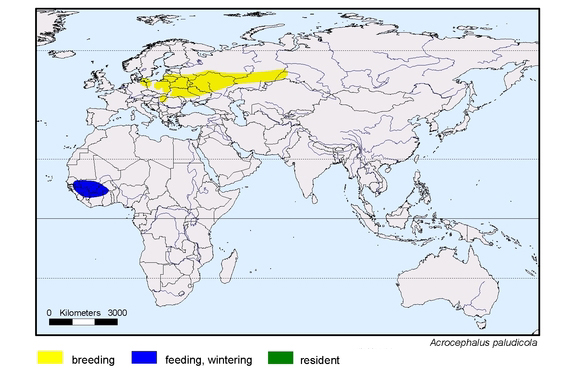
| Species fact sheet | by Global Register of Migratory Species - www.groms.de |
| Use the GROMS database for dynamic search for migratory species, new links and references. |
| Acrocephalus paludicola | (Vieillot, 1817) |
| Synonym: | |
| Family: | Muscicapidae |
| Order: | Passeriformes |
| English: | Aquatic warbler |
| French: | Phragmite aquatique |
| Spanish: | Carricerín |
| German: | Seggenrohrsänger (There's a German version of this page!) |
| Norwegian: | Vannsanger (There's a Norwegian version of this page!) |
| Migration: | intercontinental |
| Migration details: | “Locally scarce summer migrant of western Palearctic, from eastern Germany and Poland east across western and central Russia to western Siberia and south to Hungary. Winters in subtropical to tropical climatic zones of West Africa.” Baker K, 1997, Warblers of Europe, Asia and North Africa, p. [...], Christopher Helm Ltd, London |
| “Local summer visitor Germany, Poland, Czechoslovakia, ? Austria (has bred), Hungary, Romania, European USSR; winters west tropical Africa (wintering grounds little known). Scarce migrant UK, Channel Is., France (has bred), Belgium (has bred), Netherlands (has bred), Germany (formerly bred), Switzerland, Italy. Vagrant Eire (12), Spain (44), Luxembourg, Denmark (15), Norway (6), Sweden (17), Finland (3), Malta, Romania (outside breeding areas), Yugoslavia (may breed), Greece, Bulgaria, Turkey, Cyprus, Jordan, north-west Africa, Canary Is., Azores.” Parmenter T, Byers C, 1991, A guide to the Warblers of the Western Palaearctic, p. [...], Bruce Coleman Books, Uxbridge, Middlesex |
|
| Regions: | Europe, North Africa, North Asia, Sub-Saharan Africa, West & Central Asia |
“The long-distant migrant Acrocephalus paludicola is known to breed in mid latitudes of the western Palearctic, in mainly continental lowlands. Serious habitat destruction due to drainage and intensive agriculture has led to extinction of breeding populations all over western Europe. The species' decline has been observed at a rate of 40% within the last ten years, and is predicted at a similar rate for the future. It is therefore considered as "Vulnerable" (VU) (Hilton-Taylor 2000) and listed in Appendix I and II of the CMS. The western breeding population is nowadays restricted to the far north-east of Germany and to Hungary and Poland - with the Polish Biebrza marshes as largest breeding site. Autumn migration commences in July, along a western route to major stopping-over areas in Holland, Belgium, France and the United Kingdom, prior to moving south to West-Africa (de By 1990). Recent surveys have discovered previously unknown populations in the eastern part of its range, (Hilton-Taylor 2000), but migratory routes and wintering sites of eastern populations remain unknown (Glutz von Blotzheim 1991).”
Riede, K. (2001): Global Register of Migratory Species. Weltregister wandernder Tierarten. Münster (Landwirtschaftsverlag), p. 227
"[The] Aquatic warbler is one of the few globally threatened species registered in Norway (IUCN). The Slevdalsvann is the only known resting place for migrating aquatic warblers in Norway. There has been registered a growing number of migrating aquatic warblers in the Slevdalsvann between 1938 and 1996."
Fylkesmannen i Vest-Agder (2001): Verneplan Slevdalsvannet (Farsund kommune, Vest-Agder), p. 38
(translated by Ansgar Tappenhölter)
Further detailed information from the GROMS-database
Recommended link(s):
| ARKive | Aquatic warbler (Acrocephalus paludicola): description, pictures, films... |
| BirdLife international | "Expedition solves Aquatic Warbler mystery" (22-02-2007) |
| The European Commission | Discription/distribution map of the Aquatic warbler (Acrocephalus paludicola) |
| The European Commission | International Action Plan for the Aquatic Warbler (Acrocephalus paludicola) |
| BirdLife international | "Aquatic Warbler given LIFE-line" (04-12-2006) |
| AWCT | Aquatic Warbler Conservation Team |
| BTOWeb | (British Trust for Ornithology) BirdFacts |
| www.cms.int | CMS' (Convention on Migratory Species) Memorandum of Understanding Concerning Conservation Measures for the Aquatic Warbler (this Memorandum is available in as a pdf, too) |
| RSPB | The Royal Society for the Protection of Birds (factsheet) |
| RSPB | The Royal Society for the Protection of Birds: "What is the RSPB doing to help aquatic warblers?" |
| www.birdguides.com | |
| BBC.co.uk | "Rare bird's stronghold protected" |
| BBC.co.uk | "Feathers clue to warbler's travels" |
| UK-CHM | (UK Clearing House Mechanism For Biodiversity) "Bonn Convention: Aquatic Warbler MOU" |
| www.ukbap.org.uk | UK Biodiversity Action Plan – Species Action Plan: Aquatic warbler (Acrocephalus paludicola) |
| www.un.by | (The United Nations in Belarus) Alexander Kozulin, Lyubov Vergeichik & Yazep Stepanovich: "Factors affecting the fluctuations of the Aquatic Warbler Acrocephalus paludicola populations of Byelarussian mires" ACTA ORNITHOLOGICA Vol. 39 (2004) No. 1 |
| JNCC | (Joint Nature Conservation Committee) Aquatic Warbler Acrocephalus paludicola (pdf-document) |
| www.birdlife.org.ua | Ukrainian Society for the Protection of Birds – Aquatic Warbler: general information, monitoring results, project on management-planning of Desna-Dniper population of Aquatic Warbler, Pripyat population under threat |
| fatbirder | "Rarely Faithful" |
| fatbirder | "French wetlands crucial for Aquatic Warbler" |
| www.netfugl.dk | Ian Lewis: "Movements of Aquatic Warblers through Britain" |
| www.afrol.com | "‘Mystery bird’ found in Senegal park" |
| NABU | Naturschutzbund Deutschland e.V. – Aquatic Warbler Conservation Team
First short Report on the 3rd Expedition to W-Siberia |
| Wikipedia | |
| Oiseaux.net | Phragmite aquatique (in French) |
To gather more information about birds in general see the link collection at connotea.org: aves
Please help us by updating our link collection via connotea!
Feedback: mail to: Klaus Riede
by Ansgar Tappenhölter